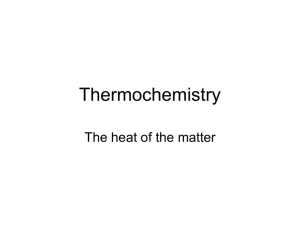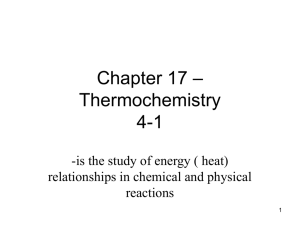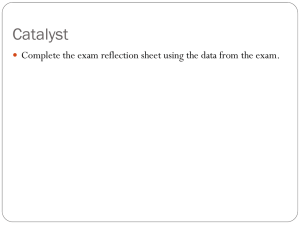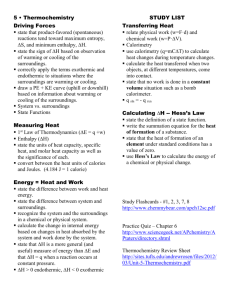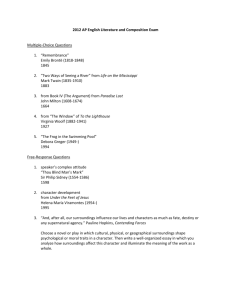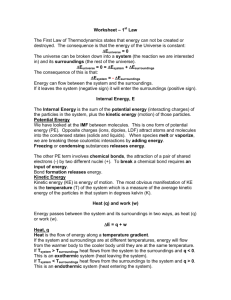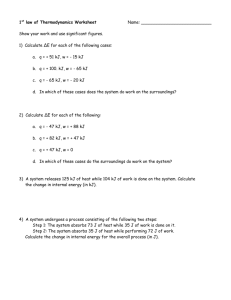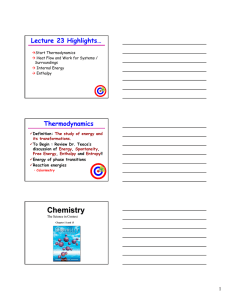Thermodynamics
advertisement
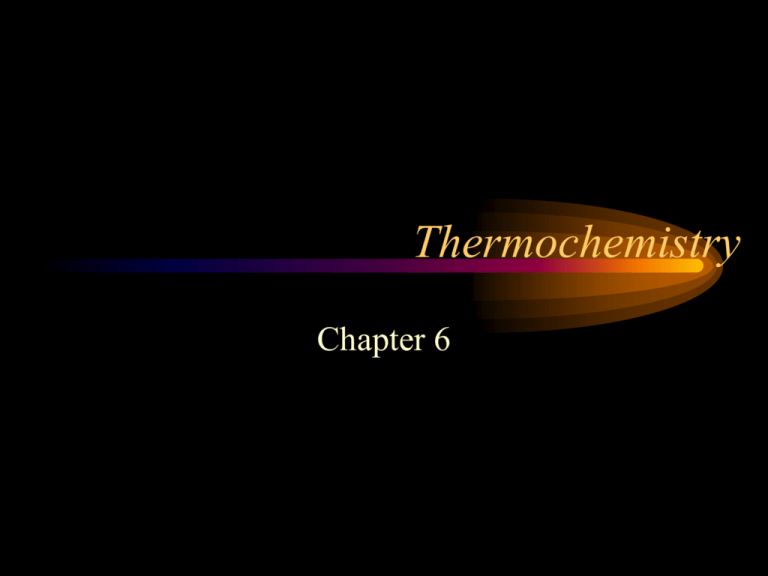
Thermochemistry Chapter 6 Homework • • • • Read Chapter 6 Due with the test Pg 275 (chapter 6 section review) 1-101 odd Nature of Energy •Energy (E) is the capacity to do work or to produce heat. •Potential energy is the energy of position or composition. • Kinetic energy is the energy due to the motion of the object and depends on the mass of the object m and its velocity v: • KE = 1/2mv2. Energy transfers • Whenever E is transferred from one object to another, it appears as work (w) and/or heat (q). • The way that energy transfer is divided between work and heat depends on the specific conditions called a pathway. • * Regardless of the pathway, the result will always be the same. State function • A state function (state property) refers to a property of the system that depends only on its present state, not on its pathway. • A state function does not depend in any way on the system’s past or future. • All variables with capital letters are state functions, having more than one pathway to reach the same value. Chemical Energy •Energy Flow to and from a System. •A system is the region where change is occurring. • •The surroundings is the other region relevant to the change. Exothermic reactions • When a reaction results in the evolution (release) of heat, it is said to be exothermic. • Heat flows out of the system to the surroundings. • In any exothermic reaction, some of the potential energy stored in the chemical bonds is being converted to thermal energy (random KE) via heat. Endothermic • Reactions that absorb energy from the surroundings are said to be endothermic. • Heat flows into the system from the surroundings. • Energy gained by one reaction must be equal to energy lost by the other. Thermodynamics • The study of energy and its interconversions is called thermodynamics. • The first law of thermodynamics states that the total energy of the universe is constant. • This is also known as the law of conservation of energy. • Energy cannot be created or destroyed but can be changed from one form to another. • Euniverse = Esystem + Esurroundings = 0. • Internal energy E of a system can be defined as the sum of the PE and KE of all particles in a system. • When a chemical system changes, energy changes. • E = Efinal - Einitial = Eproducts - Ereactants •Two scenarios. • Efinal < Einitial , E < 0. • • •Efinal > Einitial , E > 0. Heat and Work • Heat (q) is the energy transfer between the system and surroundings because of a difference in temperature. • Work (w) is the energy transfer when an object is moved by a force. • E = q + w. • The signs of q and w (+/-) is determined from the system’s perspective. Work •w is often the result of a chemical reaction producing a gaseous product, resulting in PV work. •P = pressure, V = volume •w and PV have opposite signs because when the gas expands (V is positive), work flows into the surroundings (w is negative). •http://auto.howstuffworks.com/engine1.htm Units •The joule (J) is the fundamental SI unit for energy. •1 J = 1 kg m2/s2. •A calorie (cal) is the energy required to raise 1 gram H2O by 1 oC. •1 cal = 4.184 J •1 Calories (food)= 1 kilocalorie (kcal). • A Btu is the energy required to raise 1 pound of H2O by 1 oF. Internal Energy Problem •Calculate E for a system undergoing an endothermic process in which 15.6 kJ of heat flows and where 1.4 kJ of work is done on the system. PV Work • Calculate the work associated with the expansion of a gas from 46 L to 64 L at a constant external pressure of 15 atm. Internal Energy Heat and Work • A hot air balloon is being inflated to its full extent by heating the air inside it. In the final stages of this process, the volume of the balloon changes from 4.00 x 106 L to 4.50 x 106 L by the addition of 1.3 x 108 J of energy as heat. Assuming that the balloon expands against a constant pressure of 1.0 atm, calculate E for the process (To convert between L atm and J, use 1 L atm = 101.3 J.)
